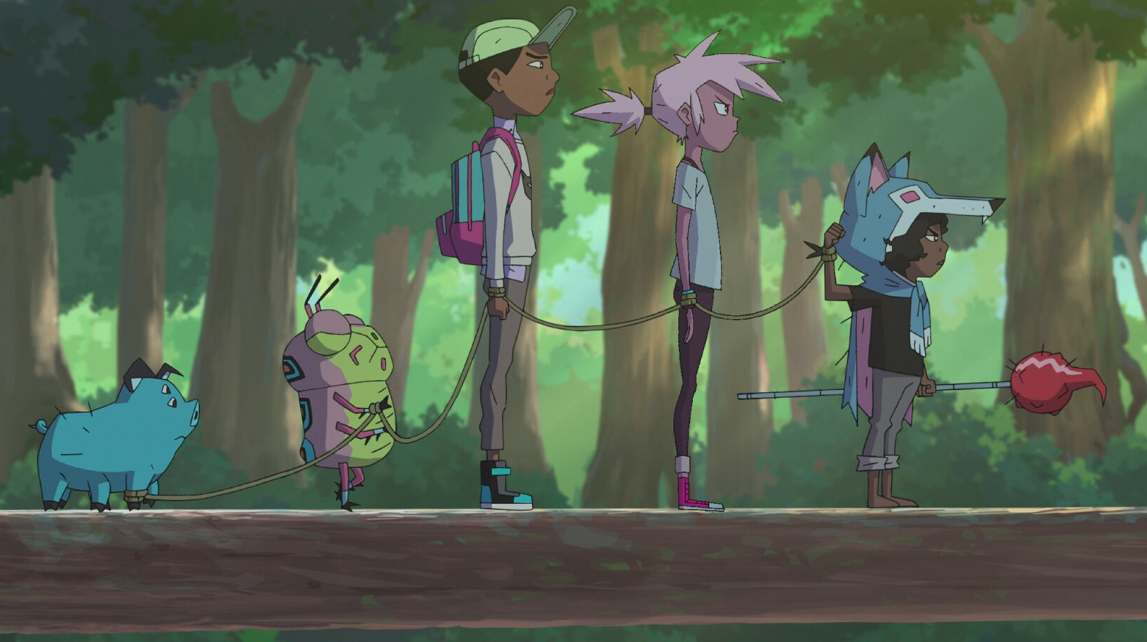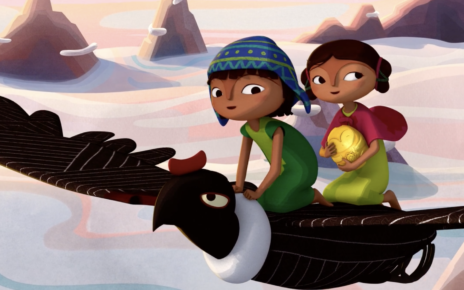The latest Dreamworks animated series to hit Netflix, Kipo and the Age of Wonderbeasts, begins in the aftermath of the end of the world. The apocalypse has already come and the inevitable post-apocalyptic restructurings are already in place. Most remaining humans live underground in burrows because the surface world is a wilderland of ruined cities, mutated animals, and over-evolved flora. The few surface-dwelling humans have to survive however they can.
Instead of opting for the bleak desolation this premise might suggest, Kipo chooses instead to give its viewers the gift of unapologetic, earnest hope. Brightly glittering, thrumming with innovative energy from its visuals and characters and winning soundtrack alike, Kipo takes an end-of-the-world quest and breathes whimsy, strength, and sheer fun into it. I don’t know about you, but I’ve been starving for a narrative just like this.
Kipo, the show’s eponymous protagonist, spent her life living in relative safety underground in a burrow with her community before a catastrophe separates her from her father and forces her miles from home andup to the surface, where the events of the series begins. There, Kipo meets a small crew of unlikely companions: Wolf, a loner by choice with a past she’s determined to keep to herself; Benson, an easygoing sweetheart who loves music; Benson’s mutated, wise-cracking insect friend Dave; and the adorable four-eyed, six-legged, blue-skinned pig Mandu. The quintet develops a tender found family dynamic and embark together on a journey to reunite Kipo with her father and her people—though they only have a smattering of leads to guide them.
We first meet Kipo very much out of her element. She’s been taught her whole life that the surface and its inhabitants are full of ruthless danger, yet once there, she approaches her new surroundings with awe and curiosity rather than fear and mistrust. She’s not overwhelmingly naive, maintaining some degree of caution, but it’s clear that her instincts tend toward compassion and enthusiasm. She can also hold her own in a fight, though she prefers to reason or riddle with the many creatures who threaten her and her newfound crew, be they Timbercats, Umlaut Snäkes, or Fitness Raccoons.
Kipo is a clever problem solver, having spent much of her time in the burrow studying with her father. And when circumstances seem daunting or downright devastating, Kipo maintains that there is a way. As a character, she serves as a consistent reminder that, even in the most dire of circumstances, a combination of resourcefulness, determination, and goodwill goes a long way.
Kipo’s intrepid leadership isn’t an unfamiliar character trait within genre fiction, but the series certainly marks one of the first times television audiences get to see it rendered with such relentless chipperness—especially in an apocalyptic world that plausibly posits itself as the natural speculative conclusion to the mess we’re making of our planet. Kipo is also committed to diverse representation: the hero braving planet Earth’s desolation in 2220 is a mixed-race girl whose fellow adventurers are all characters of color or coded as such, and most of them are Black. Queerness, too, is not only normative in this world but thoughtfully explored. Kipo gives us the first coming-out scene in an all ages animated show in which a character actually states the words “I’m gay,” as well as one of the most relatable awkward and sweet queer crush scenes I’ve ever witnessed. It’s a reminder that, even should people ruin the planet, we still have a future in which to care for each other as we are, with no exceptions or reservations. All we have to do is make it.
Hope permeates the very fabric of Kipo and the Age of Wonderbeasts. It’s in Kipo’s optimism, in her found family, in the inviting charisma of the landscape, and in the show’s deliberate inclusivity. Kipo tells its queer and POC viewers in no uncertain terms that not only do they belong in this genre, but they also get to be the heroes of these stories. You get to have fun, strange, beautiful adventures, the show seems to say. You get to fight, and love, and take care of each other. You too get to survive the apocalypse. You’ve got all the love you need. So run sure-footed, newly freed! Look at what’s ahead for you and me.
I can’t wait to find out what’s ahead for Kipo and the Age of Wonderbeasts.
Thanks for reading The Dot and Line, where we talk about animation of all kinds. Don’t forget to follow us on Twitter and sign up for our newsletter.





